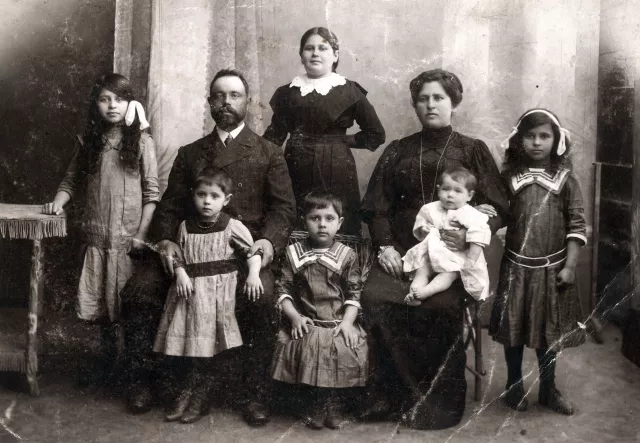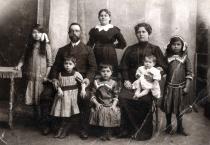The Bunin family
This picture was taken in 1913 in Slutsk.
These are my maternal grandparents, Alter-Girsh Bunin and Gita Bunina, with their six daughters: Lyubov, Reizl, Berta, Maria, Hanna and Matilda. They are all dressed like petty bourgeois, not like Jews, but they are dressed up.
Later, in 1915 and in 1921, they had two more daughters: Eshka and Pasha. They all survived the Holocaust, except for Grandmother Gita, who died in 1931. I don’t know what event this picture was taken for, but it is clear that it was taken in a photo studio.
My mother’s father was born in 1876 in the town of Slutsk, which is located 100 kilometers to the south of Minsk in Belarus, in the Jewish pale and studied in cheder.
He wasn’t an Orthodox Jew, didn’t observe Sabbath, only celebrated Jewish holidays such as Chanukkah, Rosh Hashanah and Pesach, for which national meals were cooked at home. After Grandmother’s death in 1931 the family forgot all Jewish holidays and celebrated only secular holidays, as all Soviet people did.
Grandfather dressed as the petty bourgeoisie did, who his family belonged to: he wore a jacket and shirts with ties. He always had a small full beard. Grandfather was a very fair, kind and diligent man with a sense of self-esteem. Even neighbors came to him to settle some disputes of theirs.
My grandmother was born in 1878 in Storobino in Belarus. She finished cheder, as a grown-up girl of 15 years of age, but later, by the 1900s she was already a mother of a big family and a housewife. She was a very merry and kind woman. She welcomed all distant and close relatives in her home.
Her home was very hospitable, relatives came, friends visited, all of Grandmother’s sisters, cousins, nephews came to stay, friends of her adolescent daughters came; guests were always seated at the table, even if they were unexpected, and were treated to the best food. The daughters’ friends came, sang songs, danced, recited poems.
On big Jewish holidays, like Rosh Hashanah, Pesach and Purim Grandmother collected various delicious things at home and took them to poor families in Slutsk. She was a very beautiful, kind, loving and faithful mother and wife. She dressed like the petty bourgeoisie, not like Jews: she put on dresses, blouses and skirts.
Grandmother didn’t wear a wig, she had long hair and she braided it into a beautiful braid and placed it on the back of her head. She died in 1931 in Minsk during an operation on her kidneys at a rather young age – she was 53.
She was buried in Minsk at the Jewish cemetery. When the Fascists occupied Minsk, her grave was destroyed, so she has been commemorated at Grandfather’s, her husband’s, grave, who died in 1949 in Leningrad.
When Mother’s sisters, Grandfather’s daughters, put up a monument on his grave at the Jewish Preobrazhensky cemetery, Grandmother’s name was included on the gravestone near Grandfather’s.
The first child of my maternal grandparents was a boy, but he died in infancy. After that Grandmother gave birth to eight girls: Liber-Esther, Lyubov in her passport; Beilya, Berta in everyday life – my mother; Maria; Hanna, Anna in everyday life; Reizl, Rosa in everyday life; Matlya, Matilda in everyday life; Eshka, Esphir in everyday life; and Pasha, who was born 21 years after the first daughter was born.
As they grew up, the Bunin sisters became assistants to their parents on the land and at home. They strove for education and read a lot at that time already; they learnt poems by heart and helped each other.
The girls were accustomed to labor since their childhood; they got up early in the morning and went to work in the field. They almost had no toys, toys were considered luxury.
Dresses and coats were bought cheap and durable, so that they would be worn by the younger daughters. Only Grandfather had a separate bed, all his daughters slept in twos and Grandmother slept with the youngest daughter.
Various artistic troupes came to Slutsk from different towns, but the family very seldom went to the circus and theater, they were always busy with the household.















